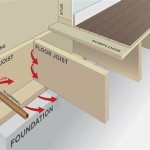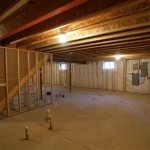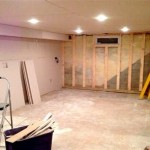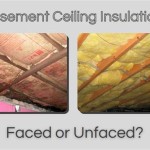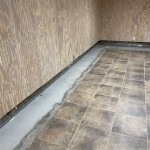How To Get Mold Off Concrete Walls in Basement
Mold growth on concrete walls in basements is a common problem arising from the inherent characteristics of basements and the nature of concrete. Basements, being primarily underground, are often susceptible to high humidity levels due to poor ventilation, water seepage through foundations, and condensation caused by temperature differences between the interior and exterior. Concrete, while appearing solid, is a porous material that can absorb moisture, providing an ideal environment for mold spores to germinate and thrive. Addressing mold growth on concrete walls involves understanding the underlying causes, employing appropriate cleaning methods, and implementing preventative measures to inhibit future outbreaks.
Mold not only poses aesthetic issues but also raises concerns about indoor air quality and potential health risks. Certain types of mold can produce allergens and irritants, potentially triggering allergic reactions, respiratory problems, and other health issues, especially in individuals with pre-existing sensitivities. Therefore, prompt and effective mold remediation is crucial for maintaining a healthy and safe living environment in the basement.
Identifying Mold Growth on Concrete Walls
The first step in addressing mold growth is accurately identifying its presence. Mold manifests in various colors and textures, ranging from white, gray, or green to black and fuzzy. Common types of mold found in basements include Penicillium, Aspergillus, Cladosporium, and Stachybotrys (black mold). Visual inspection is often sufficient for detecting mold, but it's essential to differentiate it from efflorescence, a white, powdery mineral deposit that can appear similar to mold. Efflorescence is a result of water evaporating from the concrete, leaving behind salts and minerals. Unlike mold, efflorescence is not a living organism and doesn't pose the same health risks.
To distinguish between mold and efflorescence, a simple test can be performed. Spray the affected area with water. If the substance dissolves, it is likely efflorescence. If it remains or smears, it is more likely mold. Additionally, mold often has a musty or earthy odor, which can further aid in identification. If there is any doubt, professional mold testing services can accurately determine the type of growth and provide guidance on remediation.
Cleaning Mold Off Concrete Walls
Once mold has been identified, the next step is to proceed with cleaning. This process requires careful execution and appropriate safety precautions to prevent further contamination and protect the individual performing the cleaning. Before starting, it is crucial to gather the necessary supplies, including protective gear like gloves, a respirator or N-95 mask, eye protection (goggles), and old clothing. Adequate ventilation is essential, so open windows and doors or use a fan to circulate air in the basement.
Several cleaning solutions can be used to effectively remove mold from concrete walls. One common and readily available option is a mixture of bleach and water. A solution of one part bleach to ten parts water is generally recommended. However, it is important to note that bleach can discolor concrete and may not be effective in killing all types of mold. Furthermore, mixing bleach with other cleaning agents, especially ammonia, can create toxic fumes and should be strictly avoided.
Another effective cleaning solution is vinegar. White vinegar is a natural and less harsh alternative to bleach. It can be applied directly to the mold-affected areas without dilution. Vinegar is particularly effective against many common types of mold found in basements. Borax is another natural cleaning agent that can be used. A solution of one cup of borax dissolved in one gallon of water can be sprayed or wiped onto the mold. Borax not only kills mold but also helps prevent its return.
To apply the chosen cleaning solution, use a sponge, scrub brush, or spray bottle. Thoroughly saturate the moldy areas and allow the solution to sit for about 10-15 minutes to penetrate the mold. Then, scrub the affected areas vigorously with a brush to remove the mold. Rinse the walls with clean water and dry them thoroughly. A wet/dry vacuum can be used to remove excess water and speed up the drying process. Ensure that the vacuum is properly cleaned and disinfected after use to prevent the spread of mold spores.
For particularly stubborn or extensive mold growth, a more powerful cleaning solution might be necessary. Professional mold remediation products, available at home improvement stores, can be highly effective. However, it is crucial to follow the manufacturer's instructions carefully and take all necessary safety precautions when using these products. These products often contain stronger chemicals and may require additional protective gear and ventilation.
After cleaning, carefully inspect the walls to ensure that all visible mold has been removed. It is also advisable to monitor the cleaned areas for any signs of regrowth. If mold reappears, repeat the cleaning process and address the underlying cause of the moisture problem to prevent future outbreaks.
Preventing Future Mold Growth
Preventing mold growth in the basement is just as important as cleaning it. Addressing the underlying causes of moisture is crucial for long-term mold control. Several strategies can be implemented to reduce humidity and prevent water intrusion in the basement.
Improving ventilation is a primary step. Ensuring adequate airflow in the basement helps to reduce humidity levels. This can be achieved by opening windows and doors when weather permits, using fans to circulate air, and installing exhaust fans in bathrooms and laundry areas. A dehumidifier is an essential appliance for basements, particularly during humid months. It removes excess moisture from the air, creating a less favorable environment for mold growth. Choose a dehumidifier with sufficient capacity for the size of the basement and regularly empty and clean the unit to maintain its effectiveness.
Addressing water leaks and seepage is critical. Inspect the foundation walls for cracks and seal any that are found. This can be done using concrete crack sealant or patching compounds. Ensure that gutters and downspouts are properly functioning and direct water away from the foundation. Landscaping should also be sloped away from the house to prevent water from pooling around the foundation. Improving drainage around the foundation can significantly reduce water intrusion into the basement.
Proper insulation can also help prevent condensation on concrete walls. Insulating the walls can reduce the temperature difference between the interior and exterior, minimizing condensation. Rigid foam insulation boards can be applied directly to the concrete walls. Consider using a vapor barrier in conjunction with insulation to prevent moisture from permeating the walls. Applying a mold-resistant paint or sealant to the concrete walls can also help inhibit mold growth. These products contain additives that prevent mold from attaching to and growing on the surface.
Regularly inspect the basement for signs of moisture or mold growth. Early detection allows for prompt action, preventing small problems from escalating into larger, more difficult-to-manage issues. By implementing these preventative measures, it is possible to create a dry and healthy basement environment, minimizing the risk of mold growth and ensuring a safe and comfortable living space.
In situations where mold growth is extensive, persistent, or if there are health concerns, it is advisable to consult with a professional mold remediation company. These professionals have the expertise, equipment, and training to safely and effectively remove mold and address the underlying moisture problems. They can also perform air quality testing to assess the extent of mold contamination and provide recommendations for remediation and prevention.

How To Remove Mold From Basement Walls In 2024

How To Remove Mold From Concrete Cleaning Tips Network

How To Get Rid Of And Prevent Mold Growth On Concrete Environix

How To Get Rid Of And Prevent Mold Growth On Concrete Environix

How To Get Rid Of And Prevent Mold Growth On Concrete Environix

How To Get Rid Of And Prevent Mold Growth On Concrete Environix

How To Remove Mold From Basement Walls Get Rid Of Molds Concrete Air Quality Express

How To Clean Mold On Basement Walls And Prevent Reoccurrence

How To Get Rid Of Black Mold In Your Basement Acculevel

How To Remove Mold From Concrete Basement Walls Doityourself Com

